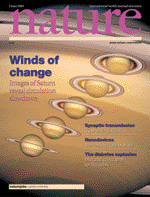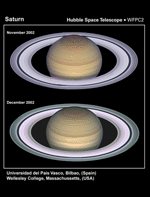One of the major mysteries in atmospheric sciences is why the giants planets Jupiter and Saturn - huge spheres composed mainly of hydrogen and helium - have an alternating pattern of East – West winds, or jets, varying in direction with latitude. Unlike the terrestrial planets, whose winds are powered primarily by sunlight, the giant planets have an additional energy source: the heat escaping from their deep interiors is of similar strength to the sunlight reaching their atmosphere. Although their combined strength is only about 1% of energy in sunlight reaching the Earth, the giant planets winds are ten times more intense than terrestrial winds. The role of these energy sources in sustaining these strong winds in giant planets, and understanding why the maximum speed is reached at the equator, constitute major challenges to theories of atmospheric motion in planets and stars.
At present, there are two quite different explanations for the system of jets on giant planets. At one extreme, the winds are thought to extend very deep into the interior of the planet, tapping the heat released from the planet to drive their motions. At the other extreme, the atmospheric circulation is modelled as on the terrestrial planets, driven by the solar heat deposited in a shallow upper atmospheric layer. Both explanations have important drawbacks, and neither can account for the strong equatorial winds.
One way to test these models is to analyse the long-term behaviour of the winds by measuring their sensitivity to changes in the amount of sunlight due to seasonal effects or to other influences. Previous studies showed that Jupiter’s winds are quite stable, and not sensitive to seasonal changes, but little was known about Saturn, whose muted cloud features are much harder to measure. Using the high-resolution capability of the Wide Field Planetary Camera onboard the HST, we have been able to track enough cloud elements in Saturn to measure the wind velocity over a broad range of latitudes. The equatorial winds measured in 1996-2001 are only half as strong as was found in 1980-81, when the Voyager spacecraft visited the planet. In contrast, the windy jets far from the equator have remained stable and show a strong hemispheric symmetry not found in Jupiter.
The different behaviour of Saturn’s winds could have a simple explanation. The long seasonal cycle in Saturn’s atmosphere (one Saturn year is about thirty terrestrial years), and the equatorial shadowing by the planet’s giant rings, could account for the sudden slowdown in the equatorial winds. Rather than being tied to the deep interior of Saturn, driven primarily by internal heat, the equatorial winds could be in part a shallow surface phenomenon, affected as well by seasonal variations in sunlight. In fact, Saturn’s equatorial region has been the location of giant storm systems, such as those seen in 1990 and 1994. These storms may have induced strong dynamical changes, perhaps resulting in the observed weakening of the equatorial winds. Another possibility is that the winds we are measuring are at higher altitudes where the winds are likely to decrease in speed. However, the fact that Saturn’s non-equatorial winds have remained unchanged during this period, resembling Jupiter in this respect, hints that these winds could be more deeply rooted.
New HST observations by the Spanish-American team are planned for the end of this year. The new data, and the high-resolution imaging to be obtained by the NASA-ESA Cassini orbital mission expected to arrive at Saturn in mid-2004, will enable us to learn whether the current wind pattern will persist, or will change over the course of Saturn’s seasonal cycle. In either case, these results will be important tests of our theoretical understanding of winds on the giant planets.
Contact:
Prof. Agustín Sánchez Lavega
Dpto. Física Aplicada I
Escuela Superior de Ingenieros
Universidad del País Vasco
Alda. Urquijo s/n
48013 BILBAO (Spain)

Updated: 05-June-2003

